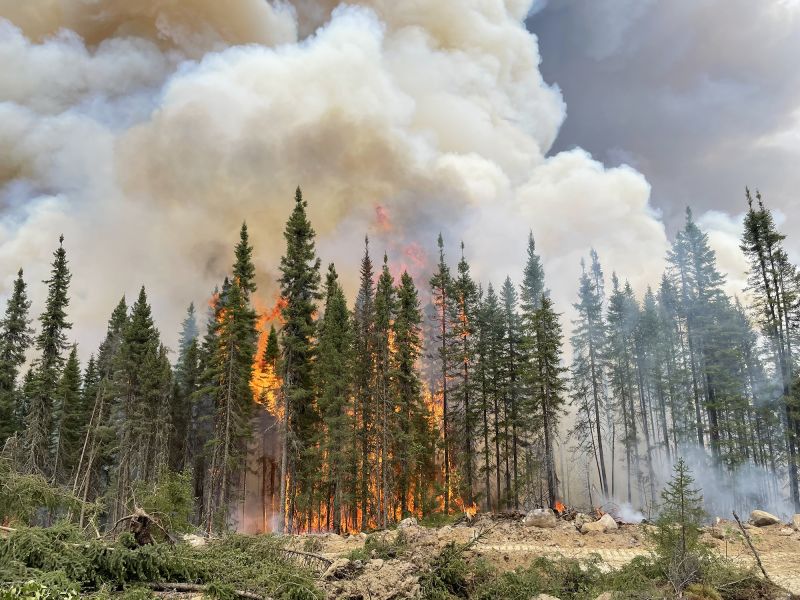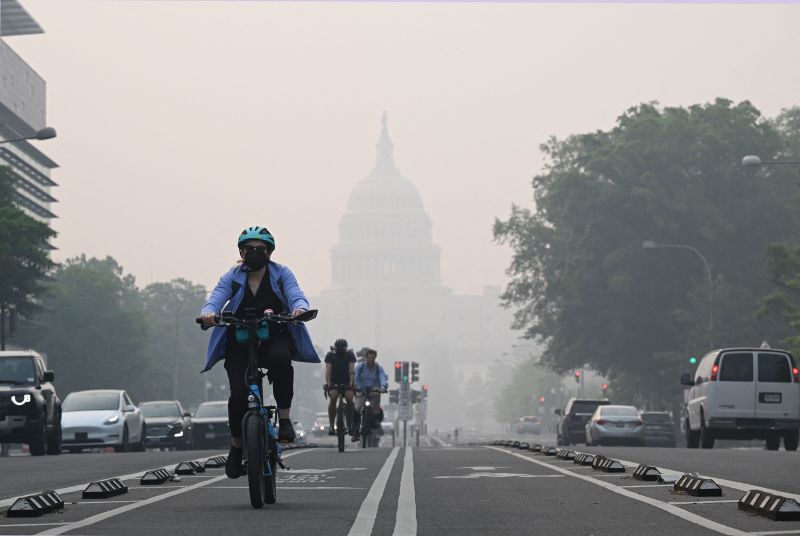
Canadian Town Faces Impending Danger as Wildfire Rages On

A raging wildfire with extreme behavior poses a serious threat to a small Canadian town, marking the early onset of a challenging wildfire season for the country. The community is at risk of being overrun by the relentless flames, highlighting the escalating wildfire crisis in Canada.
A small Canadian community is in danger as an out-of-control fire with "extreme fire behavior" is close to spreading rapidly. This is happening as Canada's wildfire season starts early for the second year in a row.
The Parker Lake Fire in northeastern British Columbia grew significantly over the weekend, now covering 13,000 acres. It is now very close to the small community of Fort Nelson. Strong winds are forecasted to push the fire closer to the community throughout Monday.
"Our current fire behavior projections indicate that the community of Fort Nelson could be affected on the morning of May 13," shared Ben Boghean, Fire Behavior Specialist for the BC Wildfire Service, in a recent update on Facebook. It is currently unknown how much the fire has spread since the last update.
Over 3,200 residents in northeastern British Columbia were placed under an evacuation order on Saturday due to the ongoing Parker Lake fire. This included approximately 2,800 residents from the Northern Rockies Regional Municipality and around 450 residents from the Fort Nelson First Nation.
"If you are still in Fort Nelson, or anywhere in the evacuation order of the Parker Lake wildfire, I encourage you to leave," said Cliff Chapman, BC Wildfire service director of provincial operations in the Sunday update. He mentioned that the fuels are extremely dry, the wind will be strong and will push the fire towards the community. This may compromise escape routes and visibility will be poor as the fire grows.
According to Jaylene MacIver, Northern Rockies regional municipality information officer, there has generally been good compliance with the evacuation orders, although some residents have chosen to stay.
The emergency operations director Terry Cavaliere informed CNN that over 90% of the around 450 residents of Fort Nelson First Nation have been evacuated from the area.
The fire on Monday is being fueled by extremely dry conditions and winds gusting up to 25 mph. However, the root cause of the fire activity can be traced back to the winter and previous years, as the planet continues to warm due to human-induced climate change.
Quebec, Canada experienced wildfires in Lebel-sur-Quevillon on June 23, 2023. This photo shows the extent of the wildfires in the area. 
Frederic Chouinard/SOPFEU/Anadolu Agency/Getty Images
Related article
The weather that fueled the destructive wildfires in eastern Canada was more likely to happen due to climate change.
According to Boghean, the area has faced several years of drought and had a lower than usual snowpack last winter. This has left the forests in the Fort Nelson zone highly vulnerable to new fires starting and spreading quickly.
Climate change is causing declining snow, increasing temperatures, and worsening droughts in Canada. This is leading to larger and more intense fires across the country, as stated by Environment Canada.
Canada experienced its most destructive fire season on record last year. In British Columbia alone, fires destroyed hundreds of homes and an area equivalent to the size of Maryland, according to the BC Wildfire Service.
The Parker Lake Fire is just one of over 100 fires currently burning in Canada. According to the Canadian Interagency Fire Centre, 39 of these fires are classified as out of control.
In Alberta, evacuation alerts have been issued for certain areas due to the MWF-017 wildfire near Fort McMurray. Officials reported that as of Sunday morning, the fire had already consumed around 16,000 acres and was still burning uncontrollably.
Hazardous smoke creeps into the US
Smoke from the infernos has caused Environment Canada to issue a special air quality statement extending from British Columbia to Saskatchewan.
Smoke from wildfires has reached the northern tier of the US for the first time this year, leading to air quality alerts being issued for Wisconsin and Minnesota. In southern Minnesota, including Minneapolis-St. Paul, air quality reached “unhealthy” levels on Monday morning, as reported by AirNow.gov.
According to the Environmental Protection Agency, high levels of particulate matter in the air can pose risks for sensitive groups or anyone spending extended periods outdoors. Wildfire smoke has been associated with an increase in certain cancers and heart-related issues, along with other health problems.
Last year, wildfires from Canada reached parts of the United States, leading to unsafe air conditions nationwide. In 2023, 19 counties in 11 states experienced days with very unhealthy and hazardous air quality, triggering at least a "code purple" alert on the US Environmental Protection Agency's Air Quality Index.
Although air quality is predicted to get better in the US by Monday, it may still remain poor in areas of Canada near the fires, such as Alberta and British Columbia.
A cyclist is seen riding under a thick haze that partially covers the US Capitol in Washington, DC on June 8, 2023. The haze is caused by smoke from wildfires in Canada, which has blanketed the US East Coast in a record-breaking smog. As a result, cities have issued air pollution warnings and thousands of Canadians have been forced to evacuate their homes. The fires have been devastating, displacing over 20,000 people and burning approximately 3.8 million hectares (9,390,005 acres) of land. Prime Minister Justin Trudeau has described this wildfire season as the worst in the country's history.
A cyclist rides under a blanket of haze partially obscuring the US Capitol in Washington, DC, on June 8, 2023. Smoke from Canadian wildfires have shrouded the US East Coast in a record-breaking smog, forcing cities to issue air pollution warnings and thousands of Canadians to evacuate their homes. The devastating fires have displaced more than 20,000 people and scorched about 3.8 million hectares (9,390,005 acres) of land. Prime Minister Justin Trudeau described this wildfire season as the country's worst ever. (Photo by Mandel NGAN / AFP) (Photo by MANDEL NGAN/AFP via Getty Images)
Mandel Ngan/AFP via Getty Images
Related article
Breathed in a lot of wildfire smoke? Wondering what to do next?
Canadian officials have advised that individuals with lung disease like asthma, heart disease, older adults, children, pregnant women, and outdoor workers are at higher risk of health effects from wildfire smoke. They suggest wearing a mask when spending time outdoors to lower exposure to fine smoke particles.
Smoke rises Friday from mutual aid wildfire GCU007 in the Grande Prairie Forest Area near TeePee Creek, Alberta.
Smoke rises Friday from mutual aid wildfire GCU007 in the Grande Prairie Forest Area near TeePee Creek, Alberta.
Alberta Wildfire/Handout/Reuters
Residents in Alberta prepare to evacuate
Evacuation alerts are currently in effect for parts of Alberta due to the wildfire known as MWF-017, which is burning approximately 10 miles southwest of Fort McMurray. The Regional Municipality of Wood Buffalo issued the alerts for Fort McMurray, Saprae Creek Estates, Gregoire Lake Estates, Fort McMurray First Nation #468, Anzac, and Rickards Landing Industrial Park.
According to a statement from the municipality, although these communities are not immediately at risk, the alerts serve as a precaution to ensure that residents are prepared to evacuate in case conditions change.
Light rain showers were anticipated Sunday night, followed by more rain on Monday, according to a recent update from Alberta Wildfire. This rainfall is expected to help decrease fire activity, providing firefighters with a favorable opportunity to further contain the fire.
The update mentioned that two night vision helicopters will be deployed overnight to assist in extinguishing the fire by dropping water from their buckets.
Crews worked on creating a fireguard on the northeast side of the fire on Sunday, according to officials.
Fire restrictions will continue to be in place in the area until conditions get better, as stated by Alberta Wildfire.
Editor's P/S:
The early onset of Canada's wildfire season is a stark reminder of the devastating impacts of climate change. The Parker Lake Fire in British Columbia highlights the heightened vulnerability of communities to wildfires due to extreme drought conditions and strong winds. The rapid spread of the fire towards the small town of Fort Nelson underscores the urgent need for proactive measures to protect vulnerable populations and ecosystems.
The hazardous smoke from these wildfires has reached the northern US, affecting air quality and posing health risks. The fact that air quality reached unhealthy levels in states like Minnesota is a testament to the far-reaching consequences of wildfires. It is crucial to raise awareness about the health risks associated with wildfire smoke and to implement measures to mitigate its impact on vulnerable communities.















